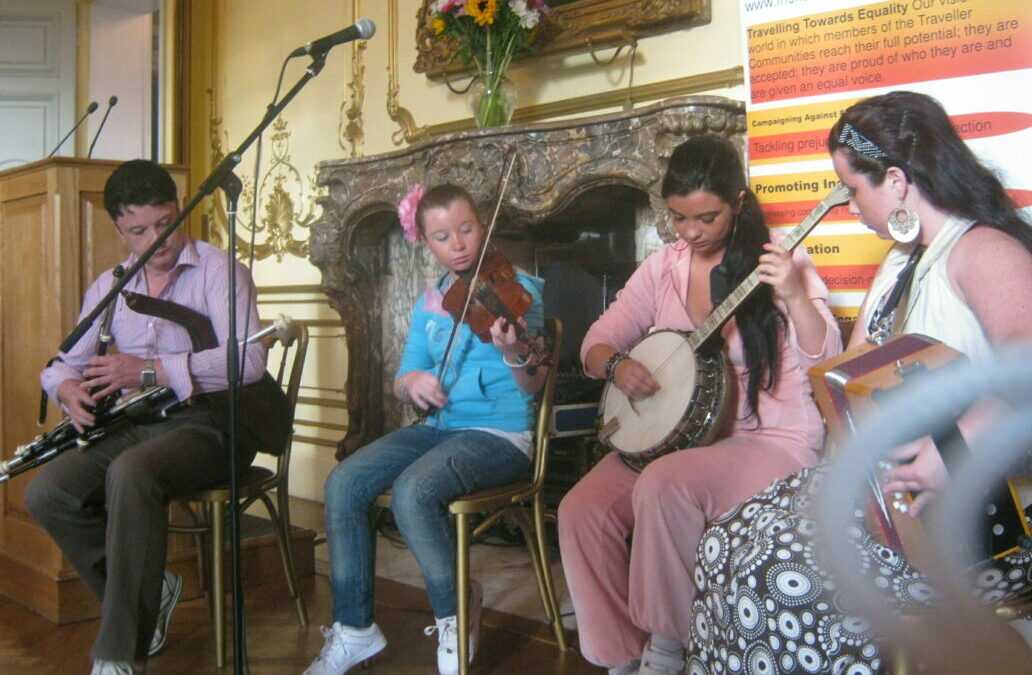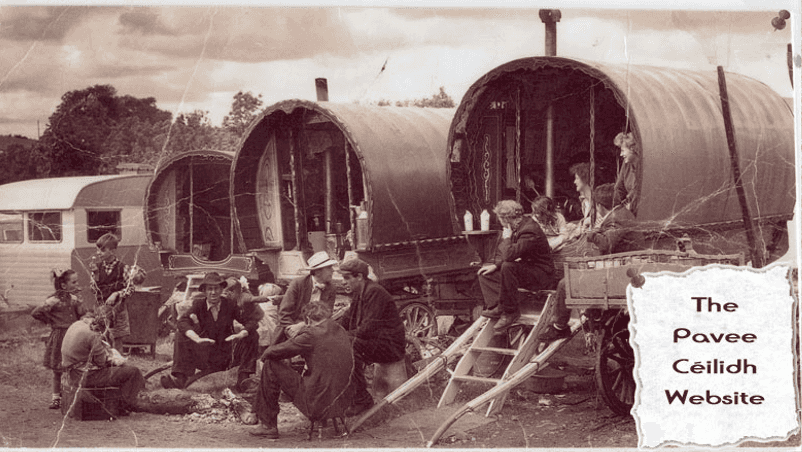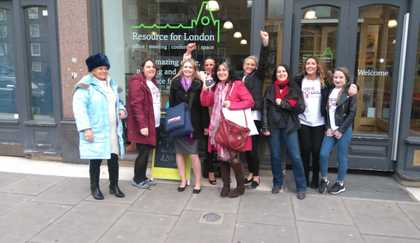
Romani (Gypsy), Roma and Irish Traveller History and Culture
Romani (Gypsy), Roma and Irish Traveller people belong to minority ethnic groups that have contributed to British society for centuries. Their distinctive way of life and traditions manifest themselves in nomadism, the centrality of their extended family, unique languages and entrepreneurial economy. It is reported that there are around 300,000 Travellers in the UK and they are one of the most disadvantaged groups. The real population may be different as some members of these communities do not participate in the census.
The Traveller Movement works predominantly with ethnic Romani (Gypsy), Roma, and Irish Traveller Communities.
Irish Travellers and Romany Gypsies
Irish Travellers
Traditionally, Irish Travellers are a nomadic group of people from Ireland but have a separate identity, heritage and culture to the community in general. An Irish Traveller presence can be traced back to 12th century Ireland, with migrations to Great Britain in the early 19th century. The Irish Traveller community is categorised as an ethnic minority group under the Race Relations Act, 1976 (amended 2000); the Human Rights Act 1998; and the Equality Act 2010. Some Travellers of Irish heritage identify as Pavee or Minceir, which are words from the Irish Traveller language, Shelta.
Romany Gypsies
Romany Gypsies have been in Britain since at least 1515 after migrating from continental Europe during the Roma migration from India. The term Gypsy comes from “Egyptian” which is what the settled population perceived them to be because of their dark complexion. In reality, linguistic analysis of the Romani language proves that Romany Gypsies, like the European Roma, originally came from Northern India, probably around the 12th century. French Manush Gypsies have a similar origin and culture to Romany Gypsies.
There are other groups of Travellers who may travel through Britain, such as Scottish Travellers, Welsh Travellers and English Travellers, many of whom can trace a nomadic heritage back for many generations and who may have married into or outside of more traditional Irish Traveller and Romany Gypsy families. There were already indigenous nomadic people in Britain when the Romany Gypsies first arrived hundreds of years ago and the different cultures/ethnicities have to some extent merged.
Number of Gypsies and Travellers in Britain
This year, the 2021 Census included a “Roma” category for the first time, following in the footsteps of the 2011 Census which included a “Gypsy and Irish Traveller” category. The 2021 Census statistics have not yet been released but the 2011 Census put the combined Gypsy and Irish Traveller population in England and Wales as 57,680. This was recognised by many as an underestimate for various reasons. For instance, it varies greatly with data collected locally such as from the Gypsy Traveller Accommodation Needs Assessments, which total the Traveller population at just over 120,000, according to our research.
Other academic estimates of the combined Gypsy, Irish Traveller and other Traveller population range from 120,000 to 300,000. Ethnic monitoring data of the Gypsy Traveller population is rarely collected by key service providers in health, employment, planning and criminal justice.
Where Gypsies and Travellers Live
Although most Gypsies and Travellers see travelling as part of their identity, they can choose to live in different ways including:
- moving regularly around the country from site to site and being ‘on the road’
- living permanently in caravans or mobile homes, on sites provided by the council, or on private sites
- living in settled accommodation during winter or school term-time, travelling during the summer months
- living in ‘bricks and mortar’ housing, settled together, but still retaining a strong commitment to Gypsy/Traveller culture and traditions
Currently, their nomadic life is being threatened by the Police, Crime, Sentencing and Courts Bill, that is currently being deliberated in Parliament, To find out more or get involved with opposing this bill, please visit here
Language
Although Travellers speak English in most situations, they often speak to each other in their own language; for Irish Travellers this is called Cant or Gammon* and Gypsies speak Romani, which is the only indigenous language in the UK with Indic roots.
*Sometimes referred to as “Shelta” by linguists and academics

New Travellers and Show People
There are also Traveller groups which are known as ‘cultural’ rather than ‘ethnic’ Travellers. These include ‘new’ Travellers and Showmen. Most of the information on this page relates to ethnic Travellers but ‘Showmen’ do share many cultural traits with ethnic Travellers.
Show People are a cultural minority that have owned and operated funfairs and circuses for many generations and their identity is connected to their family businesses. They operate rides and attractions that can be seen throughout the summer months at funfairs. They generally have winter quarters where the family settles to repair the machinery that they operate and prepare for the next travelling season. Most Show People belong to the Showmen’s Guild which is an organisation that provides economic and social regulation and advocacy for Show People. The Showman’s Guild works with both central and local governments to protect the economic interests of its members.
The term New Travellers refers to people sometimes referred to as “New Age Travellers”. They are generally people who have taken to life ‘on the road’ in their own lifetime, though some New Traveller families claim to have been on the road for three consecutive generations. The New Traveller culture grew out of the hippie and free-festival movements of the 1960s and 1970s.
Barge Travellers are similar to New Travellers but live on the UK’s 2,200 miles of canals. They form a distinct group in the canal network and many are former ‘new’ Travellers who moved onto the canals after changes to the law made the free festival circuit and a life on the road almost untenable. Many New Travellers have also settled into private sites or rural communes although a few groups are still travelling.
If you are a new age Traveller and require support please contact Friends, Families, and Travellers (FFT).
Differences and Values
Differences Between Romani (Gypsy), Roma and Irish Travellers.
Romani (Gypsy), Roma and Irish Travellers are often categorised together under the “Roma” definition in Europe and under the acronym “GRT” in Britain. These communities and other nomadic groups, such as Scottish and English Travellers, Show People and New Travellers, share a number of characteristics in common: the importance of family and/or community networks; the nomadic way of life, a tendency toward self-employment, experience of disadvantage and having the poorest health outcomes in the United Kingdom.
The Roma communities also originated from India from around the 10th/ 12th centuries and have historically faced persecution, including slavery and genocide. They are still marginalised and ghettoised in many Eastern European countries (Greece, Bulgaria, Romania etc) where they are often the largest and most visible ethnic minority group, sometimes making up 10% of the total population. However, ‘Roma’ is a political term and a self-identification of many Roma activists. In reality, European Roma populations are made up of various subgroups, some with their own form of Romani, who often identify as that group rather than by the all-encompassing Roma identity.
Travellers and Roma each have very different customs, religion, language and heritage. For instance, Gypsies are said to have originated in India and the Romani language (also spoken by Roma) is considered to consist of at least seven varieties, each a language in their own right.
Values and Culture of Romani (Gypsy), Roma and Irish Traveller Communities
Family, extended family bonds and networks are very important to the Romani (Gypsy), Roma and Irish Traveller way of life, as is a distinct identity from the settled ‘Gorja’ or ‘country’ population. Family anniversaries, births, weddings and funerals are usually marked by extended family or community gatherings with strong religious ceremonial content. Romani (Gypsy) and Irish Travellers generally marry young and respect their older generation. Contrary to frequent media depiction, Traveller communities value cleanliness and tidiness.
Many Irish Travellers are practising Catholics, while some Romani (Gypsy) and English Travellers are part of a growing Christian Evangelical movement.
Romani (Gypsy) and Traveller culture has always adapted to survive and continues to do so today. Rapid economic change, recession and the gradual dismantling of the ‘grey’ economy have driven many Romani (Gypsy) and Traveller families into hard times. The criminalisation of ‘travelling’ and the dire shortage of authorised private or council sites have added to this. Some Travellers describe the effect that this is having as “a crisis in the community”. A study in Ireland put the suicide rate of Irish Traveller men as 3-5 times higher than the wider population. Anecdotal evidence suggests that the same phenomenon is happening amongst Traveller communities in the UK.
Romani (Gypsy) and Travellers are also adapting to new ways, as they have always done. Most of the younger generation and some of the older generation use social network platforms to stay in touch and there is a growing recognition that reading and writing are useful tools to have. Many Romani (Gypsy) and Travellers utilise their often remarkable array of skills and trades as part of the formal economy. Some Romani (Gypsy) and Travellers, many supported by their families, are entering further and higher education and becoming solicitors, teachers, accountants, journalists and other professionals.
There have always been successful Romani (Gypsy) and Traveller businesses, some of which are household names within their sectors, although the ethnicity of the owners is often concealed. Romani (Gypsy) and Travellers have always been represented in the fields of sport and entertainment.
How Gypsies and Travellers Are Disadvantaged
The Romani (Gypsy), Roma and Irish Traveller communities are widely considered to be among the most socially excluded communities in the UK. They have a much lower life expectancy than the general population, with Traveller men and women living 10-12 years less than the wider population.
Travellers have higher rates of infant mortality, maternal death and stillbirths than the general population. They experience racist sentiment in the media and elsewhere, which would be socially unacceptable if directed at any other minority community. Ofsted consider young Travellers to be one of the groups most at risk of low attainment in education.
Government services rarely include Traveller views in the planning and delivery of services.
In recent years, there has been increased political networking between the Gypsy, Roma and Traveller activists and campaign organisations.
Watch this video by Travellers Times made for Gypsy Roma Traveller History Month 2021:

